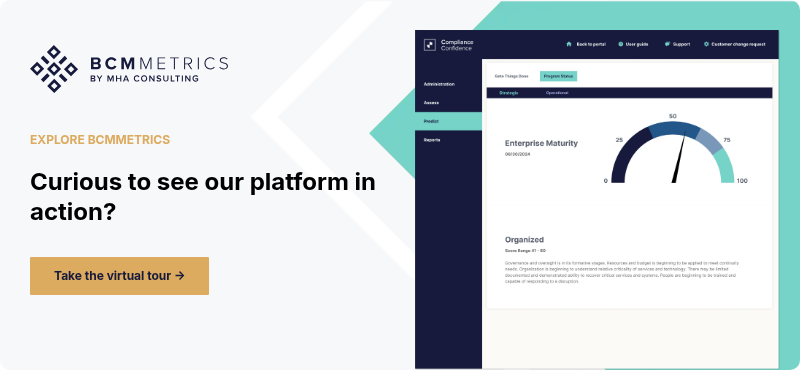Prepare For the Worst with the Best in the Business
Experience capable, consistent, and easy-to-use business continuity management software.
The world doesn’t wait for your continuity plan to catch up. The best programs are the ones that can shift quickly, stay clear-headed, and take action without losing momentum. That kind of agility doesn’t happen by accident. The right BCM software can make it much easier to stay prepared and move fast when it matters.
A Visual Definition of Agility
Do you remember the scene in The Matrix where Keanu Reeves is able to avoid getting shot by bending over backwards so fast bullets fired at him pass harmlessly over his body?
That scene could serve as a visual definition of the word agility.
It is also a pretty good depiction of how business continuity management (BCM) programs need to be these days if they are to successfully protect their organizations from the unprecedented number of threats in the environment.
You know the type of thing I mean: economic uncertainty, supply chain woes, global conflict, extreme weather, pandemic, cyberattacks, and all the rest.
In this environment, agility is not a nice to have, it’s a must have. It’s a critical BCM performance attribute.
As business continuity professionals, when we confront facility damage or the loss of a critical vendor, we need to respond swiftly, evaluating the threat and moving to meet it with purpose and coordination.
Unfortunately, many companies’ BCM programs are anything but agile. Many I’m familiar with are downright sluggish.
It’s much better for a BCM program to be an agile Neo than a sitting duck, but developing agility is easier said than done.
Why Most BCM Programs Struggle to Stay Agile
The fact is, agility is hard. It’s not natural to respond to a chaotic situation with lightning reflexes and perfect footwork. What’s natural is to duck and cover and hope you don’t get hit.
Here are five challenges companies face in trying to make their BCM programs agile:
- Complexity. The more complex a BCM program is, the harder it is for the program to adapt to new challenges. Larger organizations tend to have larger, more complex BCM programs. Managers of these programs have their work cut out for them in trying to make their programs agile and responsive.
- Lifecycle parameters. BCM programs go through lifecycles, and making changes to them is easier at some points in the lifecycle than others. A firm’s ability to change can be limited by the speed of the cycle that they are going through.
- Unfamiliarity with the BCM process. Many companies struggle to understand the BCM process as well as their business continuity needs and what the ideal program should look and feel like. That lack of understanding can be a serious impediment to their change efforts.
- Unfamiliarity with current threats and risks. The threats and risks companies face have changed a great deal in recent years and the threats are ever-evolving. Many firms are still coming to terms with the new threat environment and what to do about it.
- Fear of change. Adapting to change is always a challenge for organizations. People get used to things being a certain way and they worry that change will mean the loss of things they like or new burdens and problems. People fear the unknown and disruptions to their work and routines. They worry they won’t have sufficient budget or that changes will take place too fast. These fears are natural, but if you do not manage your fears, the result is often paralysis.
Developing agility is a challenge for any BCM program. Fortunately, there are tools available that can help.
5 Functions of BCM Software That Drive Agility
There are no magic bullets that can help a BCM program instantly attain peak agility. But there are software solutions that can help move you closer to the ideal of a nimble, responsive program.
BCM software typically performs a number of functions that can make a program more agile. Here are five of the most important:
- BCM software connects isolated functions. By delivering a unified view of the BCM program across the organization, BCM software allows organizations to connect up functions that otherwise would be carried out in separate silos. This can help your company communicate and collaborate better and respond more rapidly to change.
- BCM software improves predictive modeling. BCM software can provide the ability to quickly and concisely identify the impacts of proposed changes to your business, including the risks to your business model, your suppliers, and your financials. This allows you to better manage the resources, plans, strategies, and testing required to minimize the risks and impacts to your stakeholders. When companies build their programs on ordinary spreadsheets, they are unable to do predictive modeling.
- BCM software facilitates incremental change. BCM software can track and report the trends in improvement in the levels of compliance and reduction in risk. This facilitates the implementation of a constant stream of incremental improvements. These are the kind of improvements that we believe are the most practical and advisable. They involve evolutionary change as opposed to transformational change.
- BCM software facilitates decision-making. A key component of agility is being able to make decisions quickly and efficiently. BCM software helps with this through its ability to provide program managers with heightened visibility into their programs and risk levels. By providing an objective method for analyzing data and information, BCM software can help management make better, faster decisions.
- BCM software builds self-awareness and reduces fear. If you want your organization to become more agile, your leaders need to create a culture where you acknowledge, welcome, and move through fear. For this to happen at an individual level, the BCM professional needs to be aware of who they are. They need to identify their strengths, weaknesses, fears, and dreams. The process of using BCM software draws the individual into engaging with these topics and helps in building this self-awareness.
- Buying BCM software won’t automatically make your program more agile. But purchasing and implementing appropriate BCM software can help your program develop competencies that are important building blocks of agility.
How to Choose the Right BCM Software for Your Organization
Organizations interested in obtaining BCM software to enhance the agility of their programs have many options to choose from. In choosing such software, the key question to ask is not, “Which tools are the best?” but “Which tools are the best for us, given our particular industry, mission, company culture, priorities, and resources?”
A common mistake is for organizations to purchase more tool than they need. I’ve seen it frequently: a company buys a very complicated (and expensive) tool with all the bells and whistles; the tool has an immense learning curve; no one ever learns it; and the product ends up being the digital equivalent of an expensive paperweight.
BCMMetrics: Simple Tools Designed for Agility
I developed BCMMetrics based on my 25 years experience as a business continuity consultant helping organizations of all types and sizes become more resilient. Our clients have included small companies, midsize companies, and Fortune 100 firms as well as government agencies, nonprofit organizations, and educational institutions. They have been based all over the United States as well as overseas.
Prior to founding MHA Consulting, I was a regional VP for Bank of America, where I was responsible for business continuity across the southwest region.
I leveraged all of those experiences in developing BCMMetrics. It is designed for users who want clean, simple, straightforward tools that are light, easy to learn, and provide active guidance and actionable feedback. They are agile tools designed for a time when agility is a key performance attribute.
Here’s a rundown of the tools in our suite, in the order you would be likely to use them:
- Compliance Confidence (C2): Assesses your program’s level of compliance with your chosen BCM standard. Gives you a FICO-like score that helps identify areas for improvement.
- BIA On-Demand (BIAOD): Helps in conducting the business impact analysis. Guides you through the process of identifying the relative criticality of your business processes. Provides the questions you should ask in every BIA interview. Organizes the data to provide insights that can be easily shared with your team.
- BCM Planner: A tool that helps you build your plan templates, document your plans, integrate your BIA, and conduct management reporting, all in one secure location. Also provides a way to exercise your documents.
- BCM One: An icon-based mapping tool that visualizes critical facilities and information. Helps you organize, categorize and prioritize your global facilities for quick viewing. Provides fingertip access to critical sites, plans, and documents in an incident.
- Residual Risk (R2): Assesses your program’s residual risk. Quantitatively identifies where pockets of residual risk exist and helps you decide how to handle them.
Our tools are intuitive, secure, and get the job done. If that’s what you’re looking for in a business continuity management system, schedule a free demo of our software today. (We also offer eight hours of free consulting in the first year to help you get the most out of each tool.)
Further Reading

Michael Herrera
Michael Herrera is the Chief Executive Officer (CEO) of MHA. In his role, Michael provides global leadership to the entire set of industry practices and horizontal capabilities within MHA. Under his leadership, MHA has become a leading provider of Business Continuity and Disaster Recovery services to organizations on a global level. He is also the founder of BCMMETRICS, a leading cloud based tool designed to assess business continuity compliance and residual risk. Michael is a well-known and sought after speaker on Business Continuity issues at local and national contingency planner chapter meetings and conferences. Prior to founding MHA, he was a Regional VP for Bank of America, where he was responsible for Business Continuity across the southwest region.
.png)
.png)



